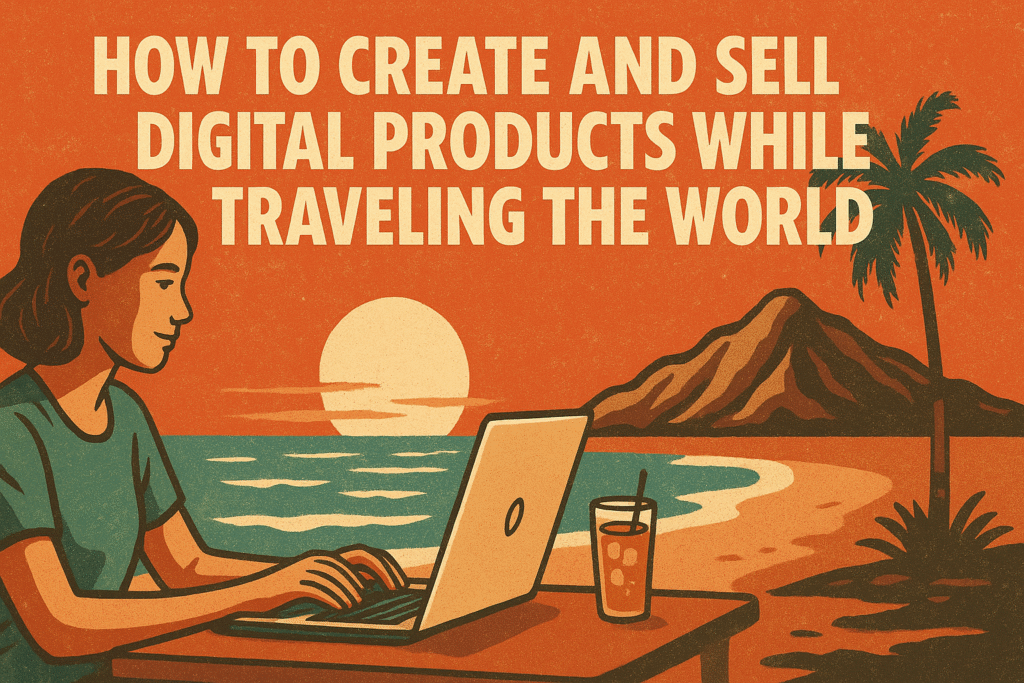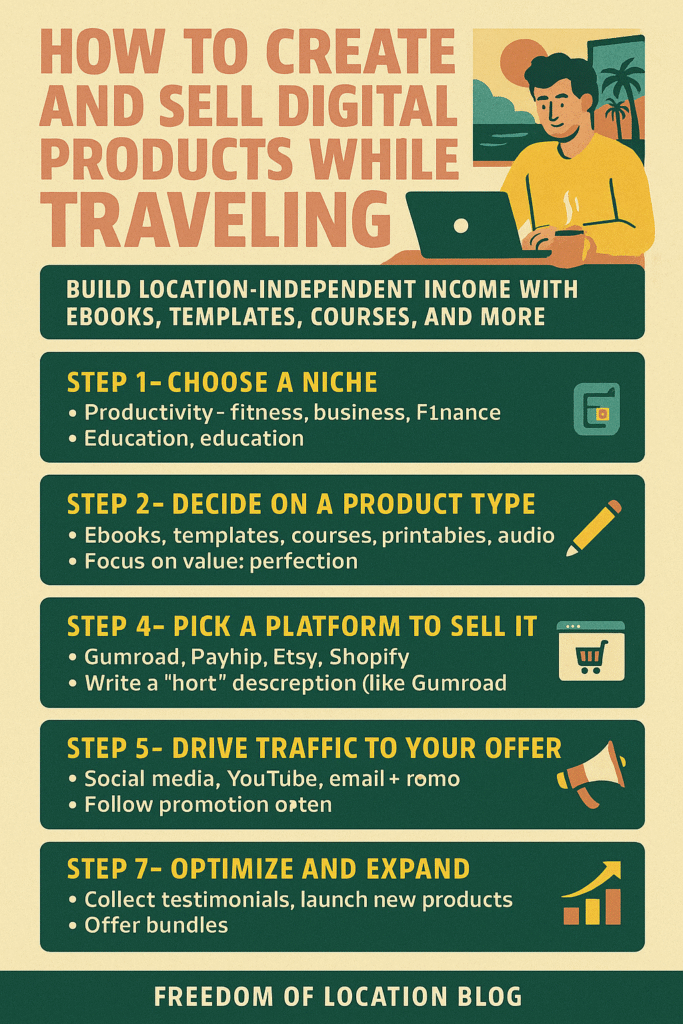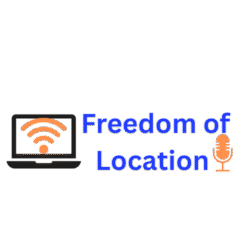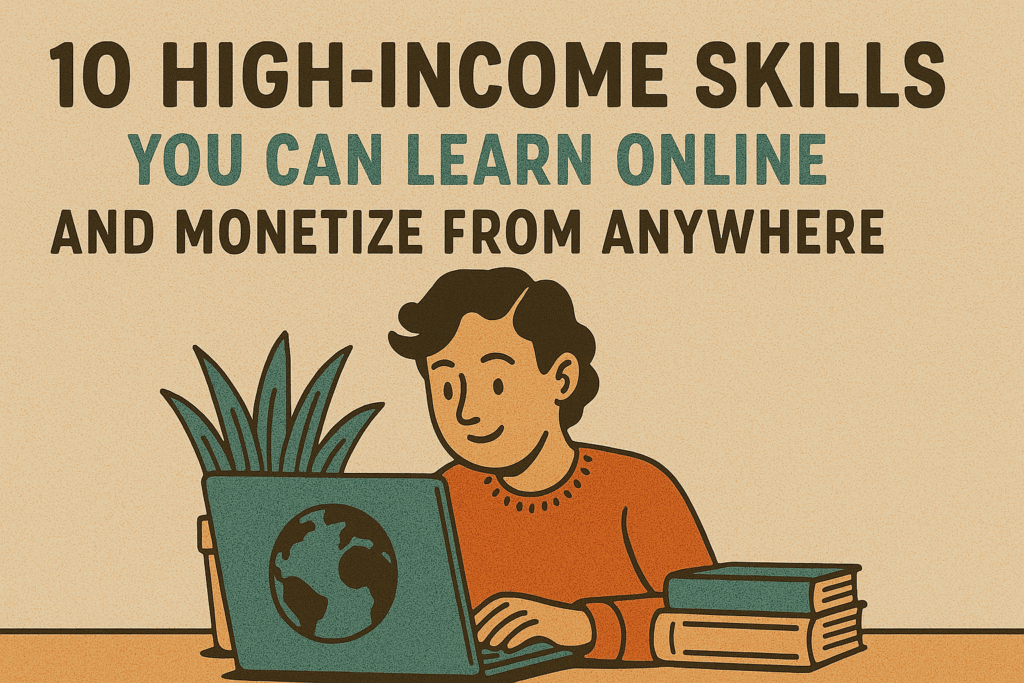
Imagine sipping coffee in a Lisbon café, exploring temples in Chiang Mai, or hiking volcanoes in Guatemala—all while your business makes money in the background. Sounds like a dream? For thousands of digital nomads and creators, it’s real life—and digital products are often the key.
Whether you’re a beginner or a seasoned freelancer, creating and selling digital products is one of the most powerful ways to build location-independent income. In this guide, you’ll learn what digital products are, how to create them, and how to sell them successfully—all while living your best travel life.
🌐 What Are Digital Products?
Digital products are intangible assets or content you can sell repeatedly without holding inventory. Think:
- Ebooks
- Online courses
- Templates
- Printables
- Audio files
- Design assets
- Software and tools
- Prompt packs or Notion planners
You create it once, upload it, and earn money every time someone buys it—no shipping, no inventory, no timezone issues.
✈️ Why Digital Products Are Perfect for Travelers
Here’s why digital products are ideal for location-independent entrepreneurs:
✅ 100% Online – No need to meet clients or ship items
✅ Passive-ish Income – Create once, sell forever
✅ Scalable – You can reach people all over the world
✅ Low Overhead – No physical office, no staff, just Wi-Fi
✅ Flexible Schedule – Launch and sell on your own terms
You can run this type of business from an Airbnb in Tulum, a hostel in Berlin, or a hammock in Bali.
🛠️ Step-by-Step: How to Create and Sell Digital Products from Anywhere
Step 1: Choose a Niche You Know or Can Research
You don’t have to be a guru. You just need to help people solve a problem, save time, or reach a goal.
Great digital product niches include:
- Productivity (Notion planners, time blocking templates)
- Fitness (meal plans, workout videos)
- Business (marketing templates, sales scripts)
- Finance (budgeting sheets, tax prep guides)
- Education (language learning PDFs, worksheets)
💬 Real Example:
Louisa, a travel blogger, created a series of Notion trip planners she sells for $19 each. In her first year, she made over $12,000—while backpacking across South America.
Step 2: Decide What Type of Digital Product to Create
Here are some product ideas by category:
| Product Type | Best For | Example |
| Ebooks | Writers, coaches, teachers | “How to Travel the World on $1,000 a Month” |
| Templates | Designers, marketers, VAs | Canva social media templates |
| Courses | Educators, freelancers | “Freelancing 101 for Remote Beginners” |
| Printables | Creatives, organizers | Budget planners, habit trackers |
| Audio | Musicians, podcasters | Lo-fi beats, meditation tracks |
💬 Real Example:
Jay, a freelance brand designer, sells Canva templates for Instagram reels and carousels. His Gumroad page generates $3K/month while he lives in Portugal.
Step 3: Create the Product (Without Fancy Tools)
You don’t need a production studio. Start simple:
- Ebooks → Google Docs or Canva
- Courses → Loom for video, Google Slides for lessons
- Templates → Canva, Notion, or Figma
- Audio → Audacity, GarageBand
- Worksheets → Google Sheets or Excel
Focus on value, not perfection.
Step 4: Choose Where to Sell It
Here are great platforms for digital product sellers:
| Platform | Best For | Fees |
| Gumroad | Beginners & creators | 10% on free plan |
| Etsy | Printables & templates | Listing + 6.5% fee |
| Payhip | Ebooks, courses | 5% (free tier) |
| Podia | Courses, memberships | $0–$39/mo |
| Shopify + App | Custom storefronts | From $39/mo |
💬 Real Example:
Sara, a yoga teacher from Brooklyn, sells digital meditation guides and printable affirmations on Etsy. She makes around $1,800/month from her side hustle.
Step 5: Set Up Your Sales Page
You need to clearly communicate:
- What it is
- Who it’s for
- What it helps with
- Why it’s valuable
Checklist:
✅ Product title
✅ Description with benefits
✅ Product mockup or screenshot
✅ Clear price
✅ Buy button
Bonus: Add a short video showing how it works!
Step 6: Drive Traffic (Without Being Salesy)
Let people know about your product. Here’s how:
- Instagram: Share behind-the-scenes, tips, and stories
- Pinterest: Great for printables and planners
- YouTube or TikTok: Demo your product
- Email Newsletter: Build a list with a freebie, then pitch
- Facebook Groups: Be helpful, then soft-sell your offer
💬 Real Example:
Marcus, a digital nomad in Thailand, promotes his spreadsheet tools on YouTube tutorials. His $27 Google Sheets planner has sold over 500 copies.
Step 7: Optimize and Expand
Once you’ve made your first sales:
- Collect testimonials
- Improve the product based on feedback
- Create upsells or bundles
- Run flash sales or discount promos
- Launch on other platforms
Every success builds momentum.
💸 How Much Can You Earn?
It depends on your niche, pricing, and effort. Here’s a rough estimate:
| Product Type | Price | Monthly Sales | Monthly Revenue |
| Budget Planner | $10 | 150 | $1,500 |
| Canva Templates | $27 | 100 | $2,700 |
| Online Course | $99 | 50 | $4,950 |
| Notion Library | $37 | 75 | $2,775 |
This is all possible from a laptop and Wi-Fi signal.
🧳 Final Thoughts: Create Once, Earn Forever
Selling digital products isn’t just a way to make money—it’s a way to buy your freedom. Whether you’re traveling full-time or just want to escape the office grind, this business model puts time, income, and location control in your hands.
You don’t need to be an influencer or a coding wizard. You just need:
- An idea that solves a problem
- A simple tool to create it
- A platform to sell it
- A message that reaches your audience
Start small. Launch. Improve as you go.
📬 Want More Tips Like This?
Join the Freedom of Location newsletter to get:
- Real success stories
- Practical income guides
- Tools and templates to launch your digital life



